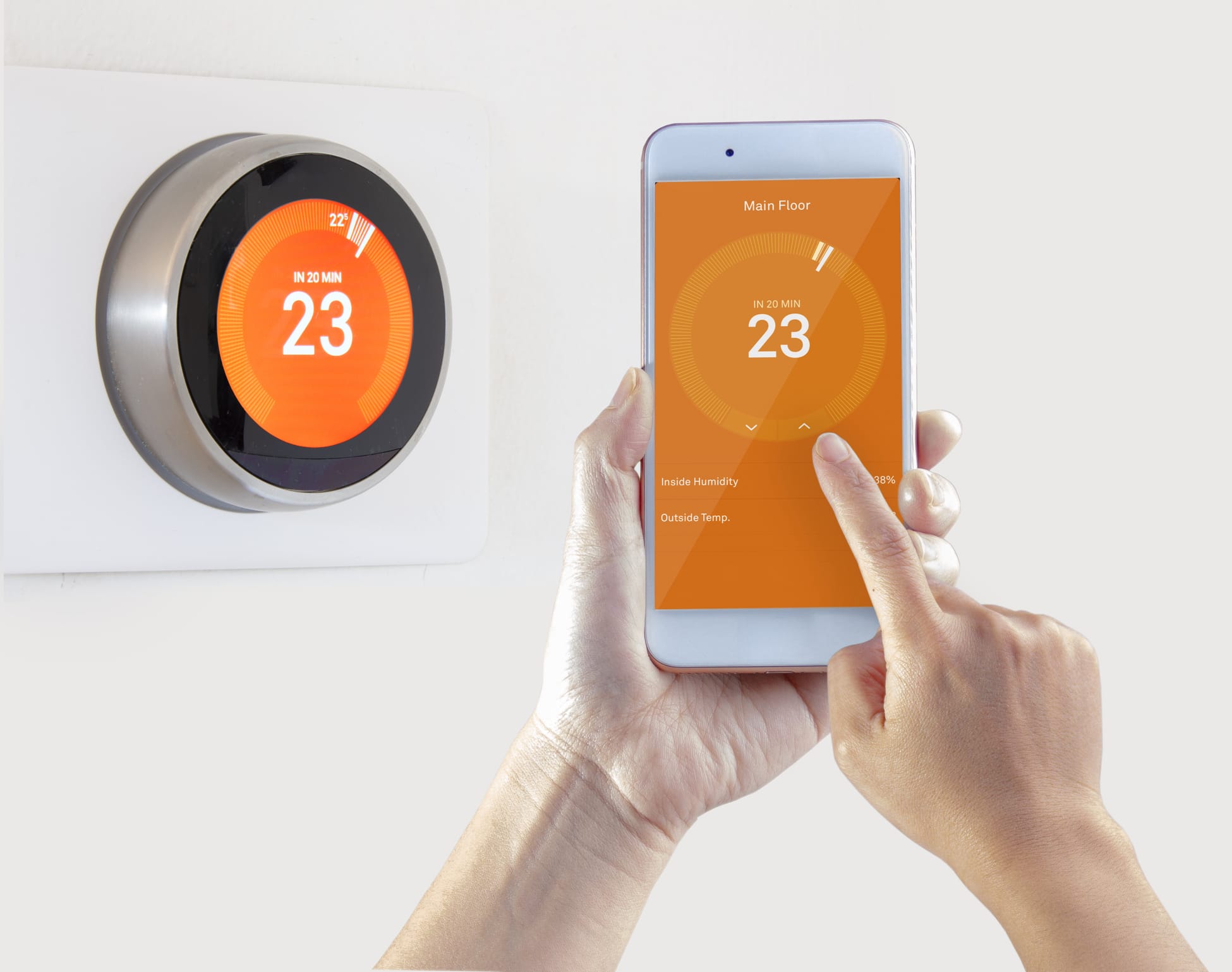
Energy-Saving Thermostat Tips for Dallas’ Fall Months
- Adjusting your thermostat during Dallas’ fall can lead to significant energy savings.
- Ideal settings: Keep it around 68°F during the day and 60-62°F at night.
- Smart thermostats offer features like scheduling and remote access, enhancing efficiency.
- Proper placement of your thermostat ensures accurate temperature readings and avoids energy waste.
- Use ceiling fans and ventilation to complement your thermostat, distributing warm air effectively.
- Nighttime adjustments can improve sleep and reduce energy bills.
- Programming your thermostat according to your schedule can optimize comfort and savings throughout the fall.
Are you looking to reduce your energy bills this fall in Dallas?
Adjusting your thermostat settings as the season changes is a great start. With Dallas’ mild yet fluctuating fall weather, making the right adjustments can significantly impact your home’s energy efficiency.
Understanding how Dallas’ climate impacts energy use is key. While the cooler weather might tempt you to turn up the heat, keeping your thermostat set to more moderate temperatures during the day can prevent unnecessary energy consumption.
With shorter days and cooler nights, a well-regulated thermostat can ensure your home stays comfortable while keeping your energy bills in check.

Understanding Basics and Functions
Do you know how your thermostat works and how it can help you save energy?
Understanding the basics and functions of your thermostat is essential to making informed adjustments for the fall season in Dallas.
Manual Thermostats are the most straightforward type, allowing you to adjust the temperature by turning a dial or pressing a button. While simple, they require frequent manual adjustments to maintain energy efficiency, which can be easy to overlook.
Programmable Thermostats offer more flexibility, allowing you to set a schedule for your heating and cooling systems. You can program different temperatures for various times of the day, ensuring your home is warm when you need it and conserving energy when you don’t. For example, setting a lower temperature while you’re asleep or away from home can lead to significant savings over time.
Smart Thermostats take energy efficiency to the next level with advanced features like learning your schedule, adjusting settings automatically, and even allowing remote control via smartphone apps. Some models include geofencing technology, which detects when you’re home or away and adjusts the temperature accordingly. Additionally, features like energy usage reports help you monitor and adjust your habits for better efficiency.
Each type of thermostat has its own advantages, but investing in a programmable or smart thermostat can provide the most significant energy savings. By understanding how your thermostat functions, you can make the best choice for your home and start saving energy this fall.
Optimal Settings for Fall in Dallas
What are the best thermostat settings for the fall months in Dallas? Knowing the optimal temperature ranges can help you strike a perfect balance between comfort and energy savings.
As the cooler fall weather rolls in, it’s recommended to set your thermostat to around 68°F during the day when you’re home. This temperature is warm enough to keep your living spaces comfortable without overworking your heating system. At night or when you’re away, you can save even more energy by lowering the temperature to 60-62°F. These adjustments can significantly reduce your energy usage, as heating systems tend to consume less energy when running at lower temperatures.
For weekdays, when you might be out of the house during work hours, consider setting to a lower temperature while you’re gone and scheduling it to return to a comfortable level just before you arrive home. Smart thermostats can handle this automatically, adjusting to your routine without requiring manual changes.
On weekends, when you’re likely to spend more time at home, maintaining a steady temperature throughout the day can ensure consistent comfort. However, even small adjustments, like lowering the temperature when you’re asleep or during the warmer parts of the day, can lead to noticeable savings on your energy bills.
By following these recommended settings, you can enjoy a comfortable home environment throughout the fall season while keeping your energy costs down.
Is it A Worthwhile Investment?
Have you considered upgrading to a smart thermostat?
Investing in a smart thermostat can be a game-changer for managing your energy use, especially during Dallas’ fall months.
Smart thermostats are designed to learn your habits and preferences, automatically adjusting the temperature based on your schedule. For instance, they can lower the temperature when you’re away and raise it when you’re about to return home. This ability to adapt ensures your home stays comfortable while minimizing energy waste.
One of the standout features of smart thermostat is scheduling. You can set different temperatures for different times of the day, and the thermostat will handle the rest. No more forgetting to adjust the settings before you leave the house—It does it for you. Additionally, many models offer geofencing, which uses your smartphone’s location to determine if you’re home or away, automatically adjusting the temperature to save energy when you’re not there.
Remote access is another valuable feature. With smart thermostat, you can control your home’s temperature from anywhere using your smartphone. Whether you’re on vacation or just out for the day, you can make sure your home is using energy efficiently.
Beyond convenience, smart thermostats provide detailed energy usage reports. These reports give you insights into your energy habits, helping you identify areas where you can cut back and save even more money.
While the initial cost of a smart thermostat might seem high, the energy savings it provides can quickly offset this expense, making it a worthwhile investment for most Dallas homeowners.
Transitioning from Summer to Fall
How do you adjust your thermostat as Dallas transitions from the heat of summer to the cooler fall months?
Gradually changing your settings is key to maintaining comfort while optimizing energy efficiency.
As the temperatures begin to drop, it’s important to avoid drastic changes in your thermostat settings. Instead, gradually lower the temperature to align with the cooling weather. For instance, if your thermostat was set to 75°F during the summer, consider lowering it to 70°F in the early fall and then to 68°F as the season progresses. This gradual approach prevents your HVAC system from overworking and helps maintain a consistent indoor climate.
During the daytime, a setting of 68°F strikes a good balance between comfort and energy savings. This temperature keeps your home warm without requiring your heating system to work too hard. In the evenings, as the outdoor temperatures drop, consider lowering the thermostat by a few degrees to 65°F. This slight adjustment can significantly reduce your heating costs without sacrificing comfort.
As you transition from summer to fall, it’s also a good time to reevaluate your weekend and weekday settings. On weekends, when you’re likely home more often, keeping a consistent temperature throughout the day might be ideal. During the week, you can save energy by lowering the thermostat while you’re at work and raising it just before you return home.
By carefully adjusting your thermostat settings as fall arrives, you can enjoy a cozy home while keeping your energy bills in check.
The Importance of Thermostat Placement
Did you know that where you place your thermostat can significantly impact its effectiveness? Proper thermostat placement is crucial for accurate temperature readings and efficient energy use, especially during the transitional fall months in Dallas.
Your thermostat works by sensing the temperature in its immediate surroundings and adjusting your HVAC system accordingly. If it’s placed in an area that doesn’t reflect the overall temperature of your home, such as near a drafty window or in direct sunlight, it can lead to inaccurate readings. This can cause your heating system to kick on when it’s not needed, leading to higher energy bills and an uncomfortable indoor environment.
The ideal location for your thermostat is on an interior wall, away from direct sunlight, drafts, doorways, and windows. It should be in a central area of your home, such as a hallway or living room, where it can get an accurate reading of the average temperature. Placing it at eye level ensures it’s not influenced by the cooler air near the floor or the warmer air near the ceiling.
Common placement mistakes include installing too close to heat sources like lamps, televisions, or kitchen appliances. These can cause the thermostat to think the room is warmer than it actually is, leading to underheating during the fall. Another mistake is placing it in a room that isn’t frequently used, which can result in inaccurate readings that don’t reflect the temperature in the areas of your home where you spend the most time.
Correcting these placement issues can make your thermostat more accurate and your heating system more efficient, helping you save energy and money during Dallas’ fall months.
Programming Your Device for Maximum Efficiency
Are you taking full advantage of your thermostat’s programming features? Properly setting up your thermostat can lead to significant energy savings, especially as the weather cools down in Dallas during the fall.
A programmable thermostat allows you to set specific temperatures for different times of the day, so you don’t have to manually adjust it constantly. Here’s a step-by-step guide to programming your thermostat for maximum efficiency this fall:
Morning Setup
Set the thermostat to warm your home to a comfortable 68°F about 30 minutes before you wake up. This ensures your living space is cozy by the time you start your day.
Daytime Settings
If your home is empty during the day, lower the temperature to around 60-62°F. This setting will save energy while you’re away. If someone is home during the day, keeping the thermostat at 68°F should maintain comfort without unnecessary heating.
Evening Adjustments
Schedule the temperature to return to 68°F about an hour before you return home. This allows your home to warm up in time for your arrival without the need for constant heating.
Nighttime Schedule
Lower the temperature to 60-62°F while you sleep. You can use extra blankets to stay warm and comfortable while reducing energy consumption.
Weekend Settings
On weekends, when you’re likely at home more often, consider maintaining a steady temperature throughout the day, adjusting it slightly lower at night.
By programming your thermostat according to your schedule, you can reduce energy usage without sacrificing comfort. For those with a smart thermostat, the process is even simpler, as it can learn your habits and make these adjustments automatically.
Taking the time to program your thermostat correctly can lead to noticeable savings on your energy bills throughout the fall season in Dallas.
Using Fans and Ventilation to Enhance Efficiency
Did you know that proper use of fans and ventilation can help your thermostat work more efficiently?
By leveraging these tools, you can maintain a comfortable home in Dallas’ fall months while reducing your reliance on heating systems.
Ceiling fans are a simple yet effective way to circulate warm air throughout your home. Most ceiling fans have a switch that allows the blades to rotate clockwise, pulling cool air up and pushing warm air down. This is particularly useful during fall when you might not need to run your heating system as often. By using ceiling fans strategically, you can keep the warm air distributed evenly without cranking up the thermostat.
Ventilation is another key factor in maintaining indoor comfort. During the fall, opening windows during the day when temperatures are mild can naturally warm your home. This fresh air flow can reduce the need for heating, especially if you close the windows before the temperature drops in the evening. Additionally, ensuring that your home’s ventilation system is clean and free of obstructions helps your HVAC system work more efficiently.
Using exhaust fans in kitchens and bathrooms can also help regulate indoor temperature and humidity levels, preventing excess moisture that could make your home feel colder. Proper ventilation helps maintain an even temperature, allowing your thermostat to work more effectively and reducing the strain on your heating system.
Incorporating fans and ventilation into your home’s fall routine can complement your settings, helping you achieve a cozy atmosphere without overusing your heating system. This approach not only enhances comfort but also contributes to lower energy bills throughout the season.
Nighttime Thermostat Tips for Better Sleep and Savings
Are you setting your thermostat for optimal sleep and savings at night? Adjusting your thermostat before bedtime can improve your sleep quality and reduce your energy bills during Dallas’ fall months.
Research suggests that the ideal temperature for sleep is between 60-67°F. Setting your thermostat within this range can help your body maintain its natural temperature regulation, leading to deeper and more restful sleep. Lowering around 62°F before bed not only creates a comfortable sleeping environment but also reduces the need for heating during the night.
To enhance warmth without overusing your heating system, consider layering your bedding. Flannel sheets, thicker comforters, and thermal blankets can provide the necessary warmth, allowing you to keep the thermostat set to a lower temperature. Additionally, wearing warmer sleepwear, such as thermal pajamas, can help you stay comfortable at night without relying heavily on your heating system.
If you prefer a slightly warmer bedroom, try using a programmable thermostat to gradually lower the temperature as you fall asleep. You can set it to start cooling the room about an hour before bedtime and then maintain a steady, lower temperature throughout the night. This gradual adjustment can help ease the transition to cooler temperatures, promoting better sleep.
Finally, avoid heating unused rooms at night by closing doors and vents in those areas. This practice focuses your heating system’s efforts on the rooms you use, ensuring efficient energy use and further savings on your energy bill.
By following these nighttime thermostat tips, you can create a comfortable sleep environment while keeping your energy costs under control during the fall season in Dallas.

FAQ
-
What is the ideal fall temperature setting for homes in Dallas?
The ideal temperature for fall in Dallas is around 68°F during the day when you’re home and 60-62°F at night or when you’re away. This balance ensures comfort while maximizing energy savings.
-
How much can I save by lowering my thermostat at night?
Lowering by 7-10°F for 8 hours a day, such as at night, can save you up to 10% a year on heating costs. This is especially effective during cooler fall nights.
-
Should I turn off my thermostat when I’m away?
Instead of turning it off completely, lower it to 55-60°F if you’ll be away for an extended period. This prevents the house from getting too cold, which could lead to problems like frozen pipes, while still saving energy.
-
Can using a smart thermostat really make a difference?
Yes, it can significantly reduce your energy usage by learning your schedule and automatically adjusting the temperature. It offers features like remote access, energy usage reports, and geofencing to optimize your home’s energy efficiency.
-
How does Dallas’ fall humidity impact thermostat settings?
Dallas’ fall can have variable humidity levels, affecting how warm or cool your home feels. Managing humidity with proper ventilation and using a dehumidifier when necessary can help maintain a consistent and comfortable temperature.


